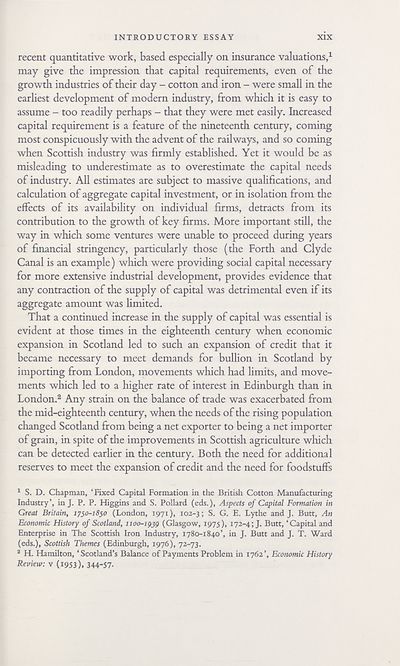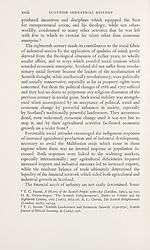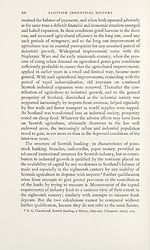Series 4 > Scottish industrial history
(24) Page xix
Download files
Complete book:
Individual page:
Thumbnail gallery: Grid view | List view

INTRODUCTORY ESSAY
xix
recent quantitative work, based especially on insurance valuations,1
may give the impression that capital requirements, even of the
growth industries of their day - cotton and iron - were small in the
earliest development of modem industry, from which it is easy to
assume - too readily perhaps - that they were met easily. Increased
capital requirement is a feature of the nineteenth century, coming
most conspicuously with the advent of the railways, and so coming
when Scottish industry was firmly established. Yet it would be as
misleading to underestimate as to overestimate the capital needs
of industry. All estimates are subject to massive qualifications, and
calculation of aggregate capital investment, or in isolation from the
effects of its availability on individual firms, detracts from its
contribution to the growth of key firms. More important still, the
way in which some ventures were unable to proceed during years
of financial stringency, particularly those (the Forth and Clyde
Canal is an example) which were providing social capital necessary
for more extensive industrial development, provides evidence that
any contraction of the supply of capital was detrimental even if its
aggregate amount was limited.
That a continued increase in the supply of capital was essential is
evident at those times in the eighteenth century when economic
expansion in Scotland led to such an expansion of credit that it
became necessary to meet demands for bullion in Scotland by
importing from London, movements which had limits, and move¬
ments which led to a higher rate of interest in Edinburgh than in
London.2 Any strain on the balance of trade was exacerbated from
the mid-eighteenth century, when the needs of the rising population
changed Scotland from being a net exporter to being a net importer
of grain, in spite of the improvements in Scottish agriculture which
can be detected earlier in the century. Both the need for additional
reserves to meet the expansion of credit and the need for foodstuffs
1 S. D. Chapman, ‘Fixed Capital Formation in the British Cotton Manufacturing
Industry’, in J. P. P. Higgins and S. Pollard (eds.), Aspects of Capital Formation in
Great Britain, 1730-1850 (London, 1971), 102-3; S. G. E. Lythe and J. Butt, An
Economic History of Scotland, 1100-1939 (Glasgow, 1975), 172-4;}. Butt, ‘Capital and
Enterprise in The Scottish Iron Industry, 1780-1840’, in J. Butt and J. T. Ward
(eds.), Scottish Themes (Edinburgh, 1976), 72-73.
* H. Hamilton, ‘Scotland’s Balance of Payments Problem in 1762’, Economic History
Review: v (1953). 344-57-
xix
recent quantitative work, based especially on insurance valuations,1
may give the impression that capital requirements, even of the
growth industries of their day - cotton and iron - were small in the
earliest development of modem industry, from which it is easy to
assume - too readily perhaps - that they were met easily. Increased
capital requirement is a feature of the nineteenth century, coming
most conspicuously with the advent of the railways, and so coming
when Scottish industry was firmly established. Yet it would be as
misleading to underestimate as to overestimate the capital needs
of industry. All estimates are subject to massive qualifications, and
calculation of aggregate capital investment, or in isolation from the
effects of its availability on individual firms, detracts from its
contribution to the growth of key firms. More important still, the
way in which some ventures were unable to proceed during years
of financial stringency, particularly those (the Forth and Clyde
Canal is an example) which were providing social capital necessary
for more extensive industrial development, provides evidence that
any contraction of the supply of capital was detrimental even if its
aggregate amount was limited.
That a continued increase in the supply of capital was essential is
evident at those times in the eighteenth century when economic
expansion in Scotland led to such an expansion of credit that it
became necessary to meet demands for bullion in Scotland by
importing from London, movements which had limits, and move¬
ments which led to a higher rate of interest in Edinburgh than in
London.2 Any strain on the balance of trade was exacerbated from
the mid-eighteenth century, when the needs of the rising population
changed Scotland from being a net exporter to being a net importer
of grain, in spite of the improvements in Scottish agriculture which
can be detected earlier in the century. Both the need for additional
reserves to meet the expansion of credit and the need for foodstuffs
1 S. D. Chapman, ‘Fixed Capital Formation in the British Cotton Manufacturing
Industry’, in J. P. P. Higgins and S. Pollard (eds.), Aspects of Capital Formation in
Great Britain, 1730-1850 (London, 1971), 102-3; S. G. E. Lythe and J. Butt, An
Economic History of Scotland, 1100-1939 (Glasgow, 1975), 172-4;}. Butt, ‘Capital and
Enterprise in The Scottish Iron Industry, 1780-1840’, in J. Butt and J. T. Ward
(eds.), Scottish Themes (Edinburgh, 1976), 72-73.
* H. Hamilton, ‘Scotland’s Balance of Payments Problem in 1762’, Economic History
Review: v (1953). 344-57-
Set display mode to:
![]() Universal Viewer |
Universal Viewer | ![]() Mirador |
Large image | Transcription
Mirador |
Large image | Transcription
Images and transcriptions on this page, including medium image downloads, may be used under the Creative Commons Attribution 4.0 International Licence unless otherwise stated. ![]()
| Scottish History Society volumes > Series 4 > Scottish industrial history > (24) Page xix |
|---|
| Permanent URL | https://digital.nls.uk/126655299 |
|---|
| Description | Over 180 volumes, published by the Scottish History Society, containing original sources on Scotland's history and people. With a wide range of subjects, the books collectively cover all periods from the 12th to 20th centuries, and reflect changing trends in Scottish history. Sources are accompanied by scholarly interpretation, references and bibliographies. Volumes are usually published annually, and more digitised volumes will be added as they become available. |
|---|


